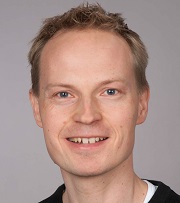AG Müller-Dahlhaus
AG Neurostimulation
Leitung

Dr. med. Florian Müller-Dahlhaus
Oberarzt
Leitung AG Neurostimulation
Facharzt für Neurologie, Facharzt für Psychiatrie und Psychotherapie
Forschung
Gesunde Hirnfunktionen basieren auf der synchronisierten Aktivität zahlreicher Neurone in weit verzweigten Netzwerken. Mittels nicht-invasiver Hirnstimulation (TMS) in Kombination mit elektrophysiologischen (TMS-EEG, EEG-TMS) und Bildgebungsmethoden (TMS-fMRI) untersuchen wir, wie Neurostimulation mit endogener Hirnaktivität interagiert, neuronale Plastizität induziert und Verhalten verändert. Umgekehrt nutzen wir Wissen über die Mechanismen der Neurostimulation, um die Pathophysiologie von Hirnerkrankungen und die Mechanismen von Therapieansprechen zu untersuchen. Unser Ziel ist es, Erkenntnisse aus diese Studien in spezifischere und effektivere Therapien affektiver Störungen zu übertragen.Wir arbeiten eng mit der AG Bergmann am Neuroimaging Center (NIC) der Universitätsmedizin Mainz zusammen (Link für “AG Bergmann”: http://www.tobergmann.de/)
Drittmittelförderung
- Boehringer Ingelheim Stiftung
- Deutsche Forschungsgemeinschaft (DFG)
Ausgewählte Publikationen
- Müller-Dahlhaus F, Bergmann TO (2023) Network perturbation-based biomarkers of depression and treatment response. Cell Rep Med 4 (6): 101086.
- Zrenner B, Zrenner C, Gordon PC, Belardinelli P, McDermott EJ, Soekadar SR, Fallgatter AJ, Ziemann U, Müller-Dahlhaus F (2020) Brain oscillation-synchronized stimulation of the left dorsolateral prefrontal cortex in depression using real-time EEG-triggered TMS. Brain Stimul 13:197–205.
- Rogasch NC, Zipser C, Darmani G, Mutanen TP, Biabani M, Zrenner C, Desideri D, Belardinelli P, Müller-Dahlhaus F*, Ziemann U* (2020) The effects of NMDA receptor blockade on TMS-evoked EEG potentials from prefrontal and parietal cortex. Sci Rep 10:3168.
- Darmani G, Bergmann TO, Zipser C, Baur D, Müller-Dahlhaus F, Ziemann U (2019) Effects of antiepileptic drugs on cortical excitability in humans: A TMS-EMG and TMS-EEG study. Hum Brain Mapp 40:1276–1289.
- Darmani G, Zipser CM, Böhmer GM, Deschet K, Müller-Dahlhaus F, Belardinelli P, Schwab M, Ziemann U (2016) Effects of the Selective alpha5-GABAAR Antagonist S44819 on Excitability in the Human Brain: A TMS-EMG and TMS-EEG Phase I Study. J Neurosci 36:12312–12320.
- Ziemann U, Reis J, Schwenkreis P, Rosanova M, Strafella A, Badawy R, Müller-Dahlhaus F (2015) TMS and drugs revisited 2014. Clin Neurophysiol 126:1847–1868.
- Müller-Dahlhaus F, Lücke C, Lu MK, Arai N, Fuhl A, Herrmann E, Ziemann U (2015) Augmenting LTP-Like Plasticity in Human Motor Cortex by Spaced Paired Associative Stimulation. PloS One 10:e0131020.
- Müller-Dahlhaus F, Ziemann U (2015) Metaplasticity in human cortex. Neuroscientist 21:185–202.
- Premoli I, Rivolta D, Espenhahn S, Castellanos N, Belardinelli P, Ziemann U, Müller-Dahlhaus F (2014) Characterization of GABAB-receptor mediated neurotransmission in the human cortex by paired-pulse TMS-EEG. Neuroimage 103:152–162.
- Premoli I, Castellanos N, Rivolta D, Belardinelli P, Bajo R, Zipser C, Espenhahn S, Heidegger T, Müller-Dahlhaus F, Ziemann U (2014) TMS-EEG signatures of GABAergic neurotransmission in the human cortex. J Neurosci 34:5603–5612.
- Müller-Dahlhaus F, Vlachos A (2013) Unraveling the cellular and molecular mechanisms of repetitive magnetic stimulation. Front Mol Neurosci 6:50.
- Vlachos A*, Müller-Dahlhaus F*, Rosskopp J, Lenz M, Ziemann U, Deller T (2012) Repetitive magnetic stimulation induces functional and structural plasticity of excitatory postsynapses in mouse organotypic hippocampal slice cultures. J Neurosci 32:17514–17523.